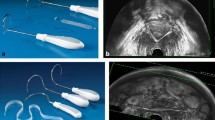Abstract
Introduction and hypothesis
The purpose of this study was to compare the results of the Q-tip test before and after the tension-free vaginal tape-obturator (TVT-O) in women with stress urinary incontinence (SUI) to determine the value of the Q-tip test in predicting the outcome of transobturator tape (TOT).
Methods
Between June 2008 and June 2009, 59 women with SUI who underwent the TVT-O procedure and were followed up for at least 6 months were analyzed. Urethral hypermobility was defined as a maximal straining angle greater than 30° as measured by the Q-tip test. Parameters of evaluation included a comprehensive medical history, physical examination, Q-tip test, stress test, and urodynamic study, which included determination of the Valsalva leak point pressure. Cure was defined as no leakage of urine postoperatively either subjectively or objectively, whereas failure was defined as the objective loss of urine during the stress test.
Results
The patients were divided into two groups according to their preoperative Q-tip angle: <30° (group 1, n = 21) and ≥30° (group 2, n = 38). The Q-tip angle decreased significantly in both groups: from 25.9 ± 5.98° preoperatively to 18.4 ± 7.23° postoperatively in group 1 (p = 0.04) and from 36.6 ± 6.75° preoperatively to 24.1 ± 5.48° postoperatively in group 2 (p = 0.03). The difference was obviously pronounced in group 2. The incontinence cure rate was significantly higher in group 2 (97.4 %) than in group 1 (85.7 %; p = 0.04).
Conclusions
Our results suggest that mobility of the proximal urethra is associated with a high rate of success of the TVT-O procedure.
Similar content being viewed by others
References
DeLancey JO (1994) Structural support of the urethra as it relates to stress urinary incontinence: the hammock hypothesis. Am J Obstet Gynecol 170(6):1713–1720
DeLancey JO (1989) Pubourethral ligament: a separate structure from the urethral supports (“pubo-urethral ligaments”). Neurourol Urodyn 8:53–61
Ulmsten U, Henriksson L, Johnson P, Varhos G (1996) An ambulatory surgical procedure under local anesthesia for treatment of female urinary incontinence. Int Urogynecol J Pelvic Floor Dysfunct 7(2):81–85
Delorme E (2001) Transobturator urethral suspension: mini-invasive procedure in the treatment of stress urinary incontinence in women. Prog Urol 11:1306–1313
Paick JS, Cho MC, Oh SJ, Kim SW, Ku JH (2007) Is proximal urethral mobility important for transobturator tape procedure in management of female patients with stress urinary incontinence? Urology 70(2):246–250
Minaglia S, Ozel B, Hurtado E et al (2005) Effect of transobturator tape procedure on proximal urethral mobility. Urology 65:55–59
Lukacz ES, Luber KM, Nager CW (2003) The effects of the tension-free vaginal tape on proximal urethral position: a prospective, longitudinal evaluation. Int Urogynecol J Pelvic Floor Dysfunct 14:179–184
Klutke JJ, Carlin BI, Klutke CG (2000) The tension-free vaginal tape procedure: correction of stress incontinence with minimal alteration in proximal urethral mobility. Urology 55:512–514
Bakas P, Liapis A, Creatsas G (2002) Q-tip test and tension-free vaginal tape in the management of female patients with genuine stress incontinence. Gynecol Obstet Invest 53:170–173
McLennan MT, Melick CF, Cannon S (2004) The position of the urethrovesical junction after incontinence surgery: early postoperative changes. Int Urogynecol J Pelvic Floor Dysfunct 15(1):44–48
Deval B, Levardon M, Samain E et al (2003) A French multicenter clinical trial of SPARC for stress urinary incontinence. Eur Urol 44:254–258
Crystle D, Charme L, Copeland W (1971) Q-tip test in stress urinary incontinence. Obstet Gynecol 38:313–315
Haylen BT, de Ridder D, Freeman RM et al (2010) An International Urogynecological Association (IUGA)/International Continence Society (ICS) joint report on the terminology for female pelvic floor dysfunction. Int Urogynecol J 21:5–26
McGuire EJ, Lytton B, Pepe V, Kohorn EI (1976) Stress urinary incontinence. Obstet Gynecol 47:255–264
Enhorning G (1961) Simultaneous recording of intravesical and intra-urethral pressure. A study on urethral closure in normal and stress incontinent women. Acta Chir Scand Suppl 276:1–68
Lo TS, Horng SG, Liang CC et al (2004) Ultrasound assessment of mid-urethra tape at three-year follow-up after tension-free vaginal procedure. Urology 63:671–675
Sarlos D, Kuronen M, Schaer G (2003) How does tension-free vaginal tape correct stress incontinence? Investigation by perineal ultrasound. Int Urogynecol J Pelvic Floor Dysfunct 14:395–398
Fritel X, Zabak K, Pigne A et al (2002) Predictive value of urethral mobility before suburethral tape procedure for urinary stress incontinence in women. J Urol 168:2472–2475
Ulmsten U, Petros P (1995) Intravaginal slingplasty (IVS): an ambulatory surgical procedure for treatment of female urinary incontinence. Scand J Urol Nephrol 29:75–82
Dietz HP, Vancaillie P, Svehla M, Walsh W, Steensma AB, Vancaillie TG (2001) Mechanical properties of implant materials used in incontinence surgery. Neurourol Urodyn 20:530
Bergman A, Koonings PP, Ballard CA (1989) Negative Q-tip test as a risk factor for failed incontinence surgery in women. J Reprod Med 34:193–197
Karram MM, Bhatia NN (1988) The Q-tip test: standardization of the technique and its interpretation in women with urinary incontinence. Obstet Gynecol 71:807–811
Conflicts of interest
None.
Author information
Authors and Affiliations
Corresponding author
Rights and permissions
About this article
Cite this article
Kim, SO., Jung, H.S., Jang, W.S. et al. Measurement of the Q-tip angle before and after tension-free vaginal tape-obturator (TVT-O): preoperative urethral mobility may predict surgical outcome. Int Urogynecol J 24, 1005–1009 (2013). https://doi.org/10.1007/s00192-012-1978-6
Received:
Accepted:
Published:
Issue Date:
DOI: https://doi.org/10.1007/s00192-012-1978-6




